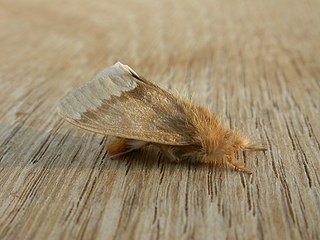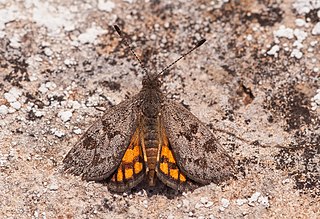
Synemon plana, commonly known as the golden sun moth, is a diurnal moth native to Australia and throughout its range, it is currently classified as vulnerable under the Environment Protection and Biodiversity Conservation Act 1999.
Hyarias is a monotypic tiger moth genus in the family Erebidae erected by Charles Swinhoe in 1892. Its only species, Hyarias metarhoda, was described by Francis Walker in 1856. It is strictly endemic to the Philippines.

Sandava xylistis, the rusty snout, is a moth of the family Erebidae first described by Charles Swinhoe in 1900. It is found in the Australian states of Victoria and Queensland, New South Wales, Tasmania, South Australia and the Australian Capital Territory.

Hippotion rosetta, or Swinhoe's striated hawkmoth, is a species of sphingid moth in the family Sphingidae. The species was first described by Charles Swinhoe in 1892.

Euproctis baliolalis, the browntail gum moth, is a moth of the family Erebidae. The species was first described by Charles Swinhoe in 1892. It is found in the south-east quarter of Australia.

Synemon is a genus of moths within the family Castniidae. It was described by Edward Doubleday in 1846. The genus contains 24 described and 20 undescribed species. These species are found across mainland Australia and on Kangaroo Island, with the highest diversity in Western Australia. Synemon species can be found in a range of habitats, including woodlands, heathlands and native perennial grasslands. The adults fly during the daytime in warm to hot weather. They have clubbed antennae, and are often mistaken for butterflies.

Anomis planalis, the common cotton looper, is a moth of the family Erebidae. The species was first described by Charles Swinhoe in 1902. It is found in northern Australia.

Synemon theresa, the cryptic sun-moth, is a species of day-flying moth of the family Castniidae. It was described by Edward Doubleday in 1846. It has a wingspan of 26-40mm, and is mostly grey-brown with orange hindwings. Native to Australia, this species is extinct in Victoria, and is now only known from a relatively small area of South Australia near Adelaide. It uses Themeda triandra and Rytidopserma spp. as larval food plants. Adults can be found from November to February. They only live for a few days, as they do not have a feeding proboscis. Despite becoming extinct over much of its former range, the cryptic sun-moth is not listed as a threatened species in South Australia.

Synemon discalis, the small orange-spotted sun-moth, is a moth in the Castniidae family. It is found in Australia, including South Australia, Western Australia and Victoria.
Synemon jcaria, the reddish-orange sun-moth, is a moth in the Castniidae family. It is found in Australia, including Victoria.
Synemon nais, the orange sun-moth, is a moth in the Castniidae family. It is found in Australia, including Victoria, South Australia and south-eastern Western Australia.

Synemon parthenoides, the orange-spotted sunmoth or link moth, is a moth in the Castniidae family. It is found in Australia, including Victoria, Western Australia and South Australia.
Synemon selene, the pale sun-moth, is a moth in the Castniidae family. It is found in Australia, including Victoria and South Australia.

Synemon gratiosa, the graceful sun-moth, is a moth in the Castniidae family. It is found in Western Australia, from Namburg National Park in the north to Mandurah in the south.
Synemon magnifica, the magnificent sun-moth, is a moth in the Castniidae family. It is found in Australia, including New South Wales.

Europlema desistaria is a species of moth of the family Uraniidae first described by Francis Walker in 1861. It is found in India, Sri Lanka, Myanmar, Thailand, Taiwan, Borneo, Sulawesi, Flores and Queensland.

Diuris chryseopsis, commonly known as common golden moths or small snake orchid, is a species of orchid that is endemic to south-eastern Australia. It is a common and widespread species growing in woodland, often in colonies and has up to four drooping, golden-yellow flowers. It is similar to several other orchids and form hybrids with some other Diuris species.
The Queanbeyan Nature Reserve is a protected nature reserve that is located in the Southern Tablelands region of New South Wales, in eastern Australia. The 67-hectare (170-acre) reserve is situated approximately 4 kilometres (2.5 mi) west-south-west of the City of Queanbeyan.

The Northern Plains Grassland (NPGL) is an open, shrubby temperate grassland community located in northern Victoria straddling the Murray Darling Depression and Wimmera, extending to the Riverina and South Western Slopes regions in southern New South Wales. Floristically rich, the area features 30 native plant species per 100 m2.












